Table of Contents
Visit Chefchaouen
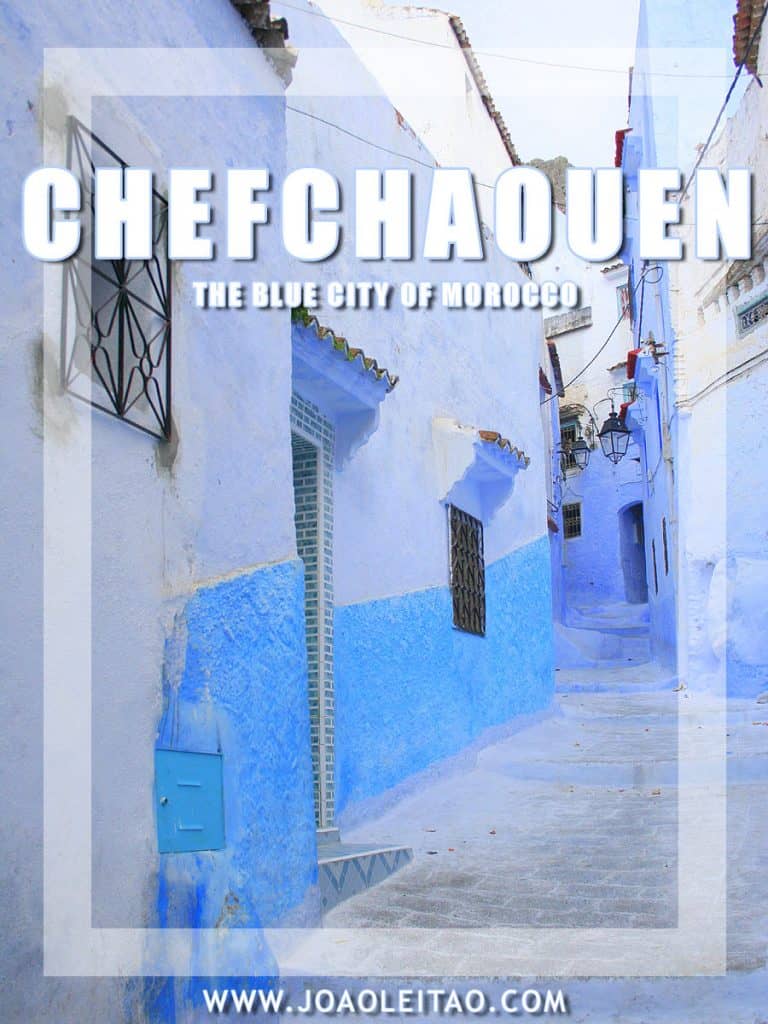
Chefchaouen is undoubtedly one of the most picturesque and photogenic cities in Morocco. Somehow, this blue painted old city stands out with a peculiar charm.
Chefchaouen was founded back in 1471 and hosted a population composed mainly of Andalusian Moors. There’s a small fortress called La Kasbah that was built to fight the Portuguese invasions of northern Morocco.
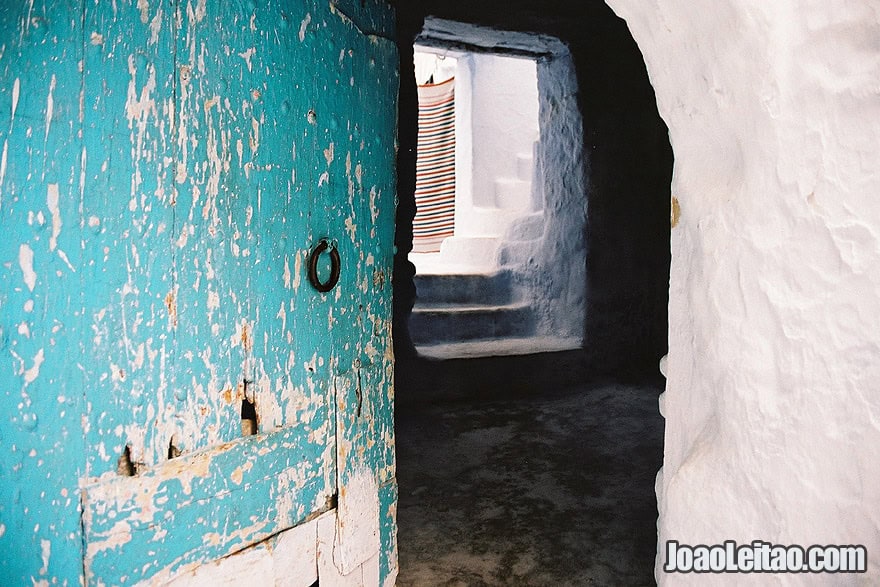
Chefchaouen, known as the blue city, is considered by many the most picturesque place in Morocco. It’s located on the North side of the country, not too far from Tetouan, and close to the Talassemtane National Park.
Around 40,000 people live there, mostly part of Berber tribes, now that the times of the bustling mellah are long gone.
When you go to Morocco, you have to visit Chefchaouen!
Its popular nickname says a lot about the city:
Most of the buildings in the medina are painted blue, as are their doors and windows. Seen from afar, the Chefchaouen historic center is overpowered by this color, that almost merges with the sky that, around here, is typically cloudless.
As for its real name, Chefchaouen, it comes from the city’s location between two mountainous peaks: “Chef” = Look and “Chaouen” = Horns.
Introduction to Chefchaouen
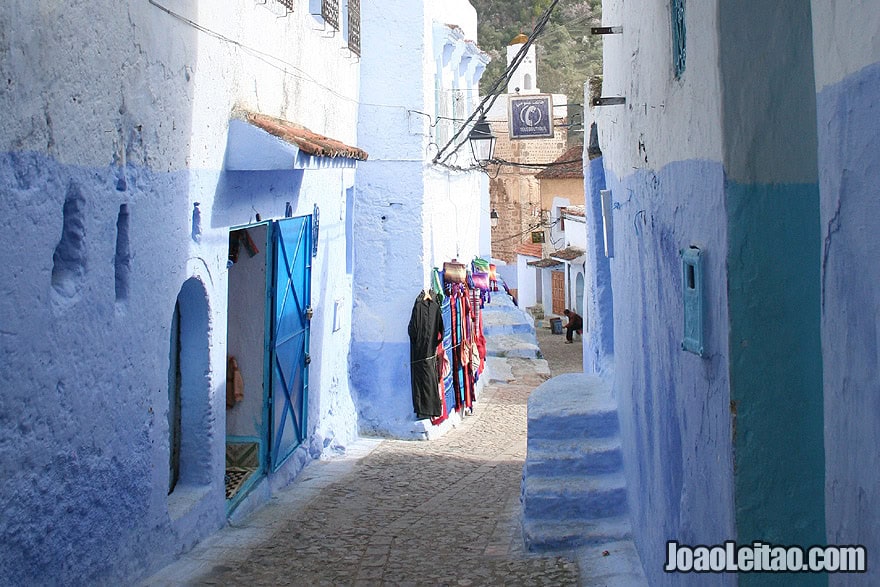
Chefchaouen was founded in 1471. It was then a small fortified settlement, a Kasbah created by Moulay Ali ibn Rashid al-Alami as part of a defense system from the Portuguese in the North of Africa. The founder was the cousin of a tribe leader, Abu Youma, that had once before found refuge there and established a safe base to launch attacks on the Portuguese. He died in one of those battles.
Its inhabitants were essentially from Ghomara tribes, native in the area, but when the Jewish were expelled from the Iberian Peninsula in 1492, and the persecutions to the Mozarabs continued, the population of Chefchaouen grew with refugees from Europe.
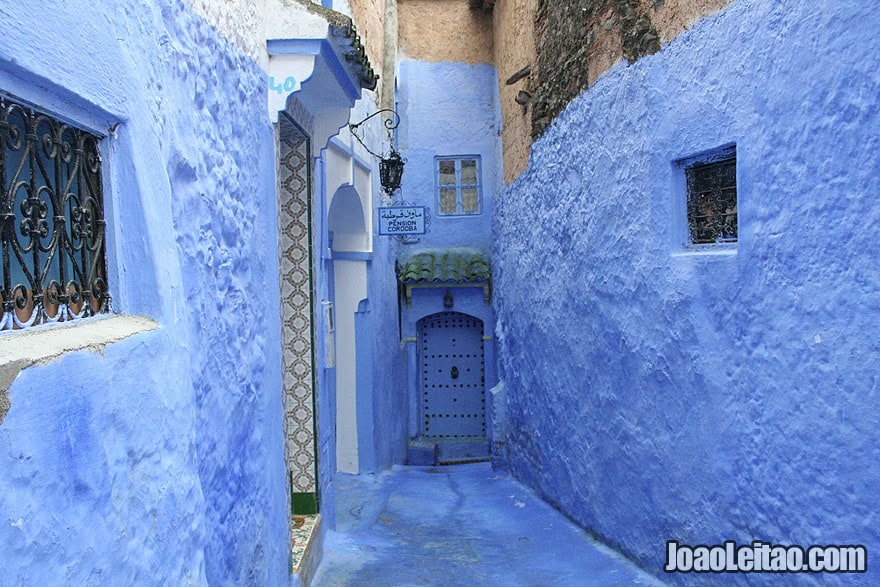
During the Second World War, the Jewish community grew even more, as more refugees arrived after escaping the Nazis, which might have increased Chefchaouen’s blue “wave.” After the war was over, most of these Jewish people left Morocco to establish themselves at the newly created State of Israel.
According to history, it was the Sephardic Jewish who brought the habit of painting the houses blue. To them, this color represents heaven and paradise, an ever-present sign of the need to lead a spiritual life. The same trend spread to other parts of the world like in Safed, Israel, but it became more popular in Chefchaouen.
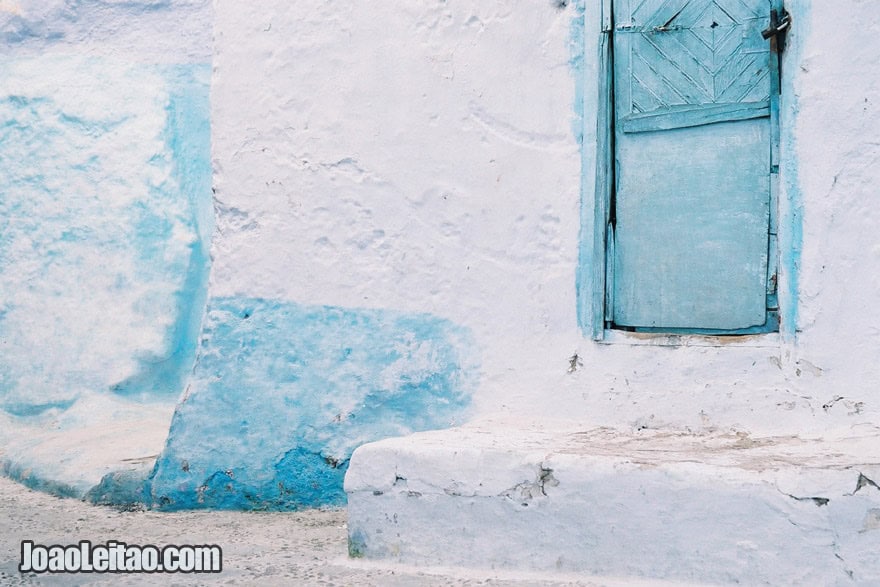
According to the elders, they used this blue color only in the part of the city where the Jewish community lived, the mellah, and they remember a completely white medina.
What made them paint the old city of Chefchaouen mostly blue is still a mystery, and some even say that the tradition of decorating the walls blue goes back to the 15th century when the city was founded.
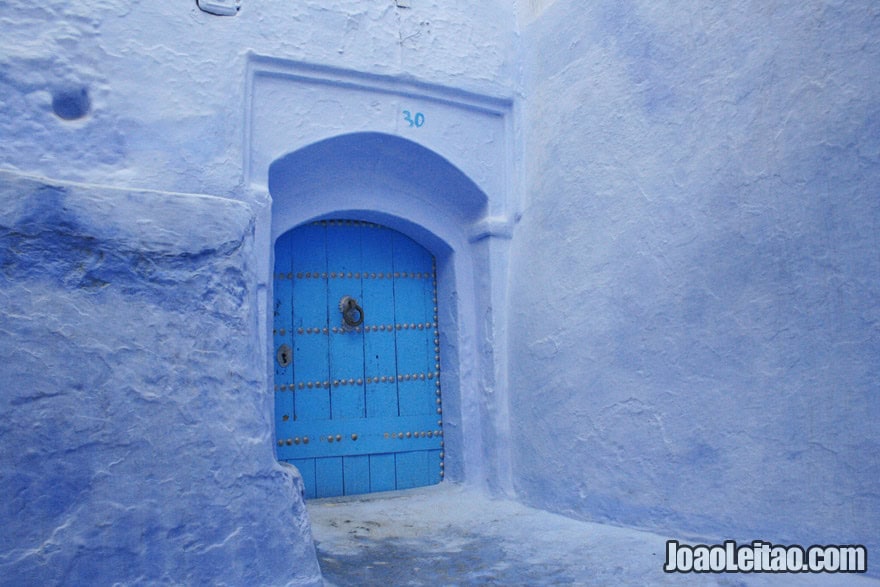
However, some people contradict this reason behind the blue color of Chefchaouen, saying it’s meant for more practical purposes like keeping the mosquitoes away or making the houses feel cooler in the hot summer months. Others think of it as a symbol of water and say that each shade of blue that you’ll find in the city matches all the variations in the Mediterranean Sea. Or that they chose blue for Chefchaouen as a tribute to Ras el-Maa, the waterfall where locals collect their drinking water.
On the other hand, if you ask the locals, many will say that blue is a beautiful color, and that’s why they painted the houses like that.
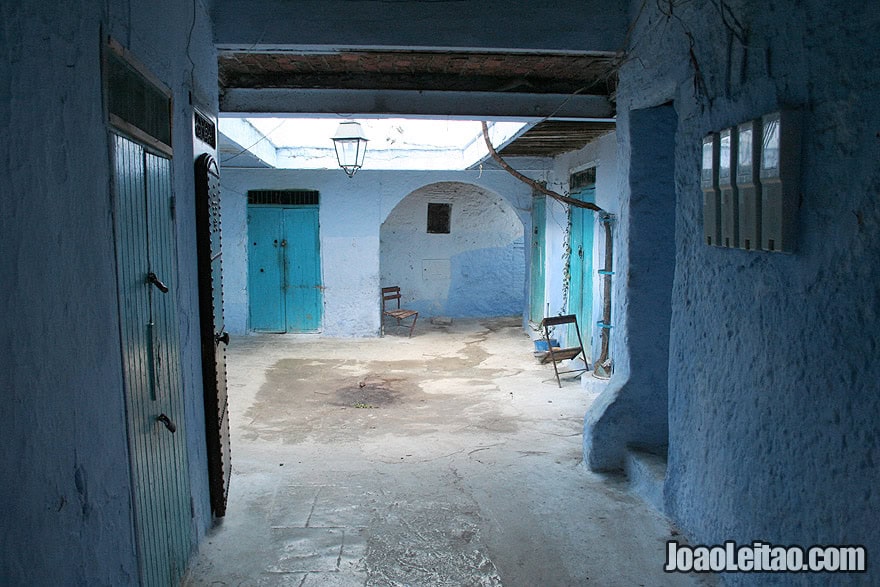
Last, but not least, keep in mind that Moroccan are smart people: they know their city became famous because of the blue color, and that tourism is a valued industry for the local economy. If there were no other reasons, it would be important to keep the city blue for tourists, and the local government provides locals with the paint, so they keep the city as it is.
In addition to the gorgeous architecture and the atmosphere of the old city, there’s another reason why Chefchaouen became so popular as a tourist destination especially for the European who can easily reach from across the Gibraltar Strait – the cannabis plantations. Although it’s illegal, it’s hard to visit the city without finding someone trying to sell us this drug. And, of course, many visitors see that as an advantage.
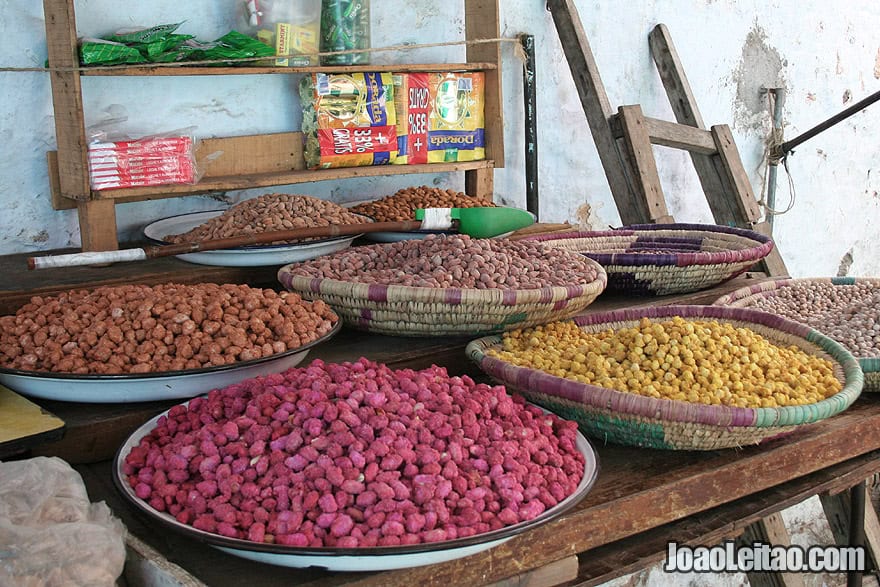
Today, Chefchaouen (or Chaouen, how sometimes Moroccans call it) is a charming city attracting tourists from all over the world. But that wasn’t always the case: as with many walled places in Morocco, it was forbidden to foreigners until 1920. Especially Christians, who could face a death sentence if they dared to get inside, a rule that ended when Spain took over this part of the country. Isolation was so deep that Sephardic spoke an archaic version of Castilian, the language their ancestors spoke when they escaped the Iberian Peninsula at the end of the 15th century.
There’s a lot more to see and do in the city in addition to the fantastic blue pictures. It’s a great place to shop, with calmer and less pushy vendors that you usually meet elsewhere in Morocco. Besides, the food is great, and the streets are safe.
Curiosities about Chefchaouen
- Chefchaouen has an extensive and remarkable religious heritage with dozens of mosques, oratories, zaouias, and mausoleums. Because of this irrefutable legacy, Chefchaouen earned the name of El-Madina Es-Saliha – the Holy City;
- This Moroccan destination is the perfect place to spend a few days, exploring the medina, taking pictures and relaxing in its several street cafés – while drinking a delicious mint tea;
- Christians were prohibited from entering Chefchaouen under death penalty. The first non-Muslim that finally visited the city in 1883 was the explorer Charles de Foucauld.
When to Visit Chefchaouen
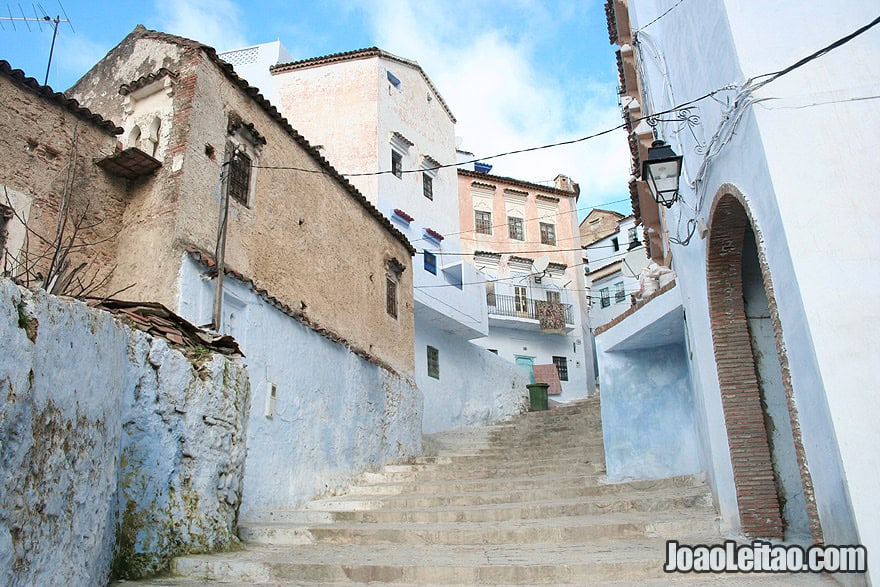
As with many other places in Morocco, the best time to plan a trip to Chefchaouen is immediately before or after summer, for more pleasant days and frequent clear blue skies. July and August might be too hot for a comfortable stay, especially considering how the city is hilly, and the winter can be as or more harsh than in Europe.
Chefchaouen City Guide
Day 1 in Chefchaouen – What to Visit
1. Medina
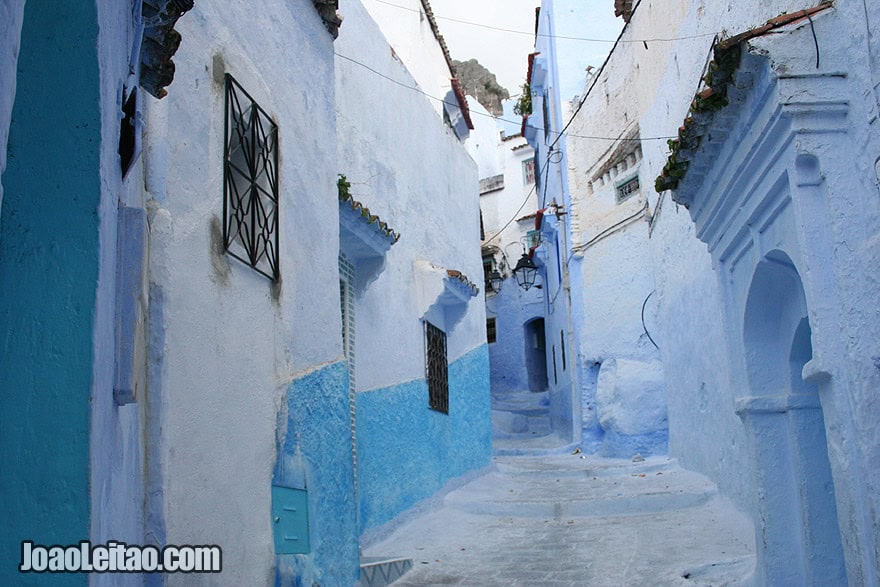
The Chefchaouen medina is what really brings the tourists to the city. That is where you’ll find the famous blue, the streets painted in that beautiful color, the typical houses, the vases hanging from the walls with colorful flowers to break the monochromatic look.
There aren’t many highlights in the Chefchaouen medina. The goal is to wander the alleys and streets, paying attention to the ancient doors, windows, children playing, the fountains. And look for those secluded places that played a role in the past, like the old prison or the communal oven.
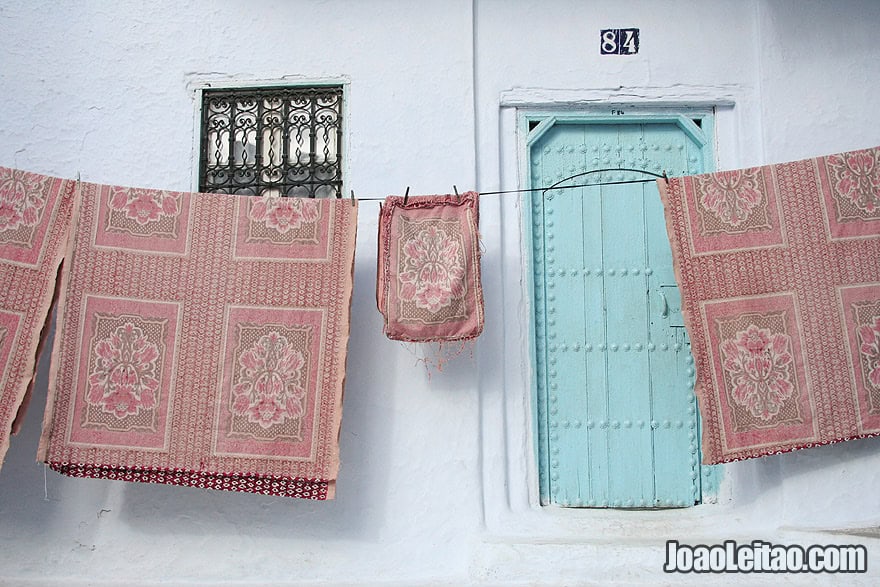
Unfortunately, the medina continues to stretch uphill, so account for the extra physical effort especially in the hotter days.
2. Kasbah
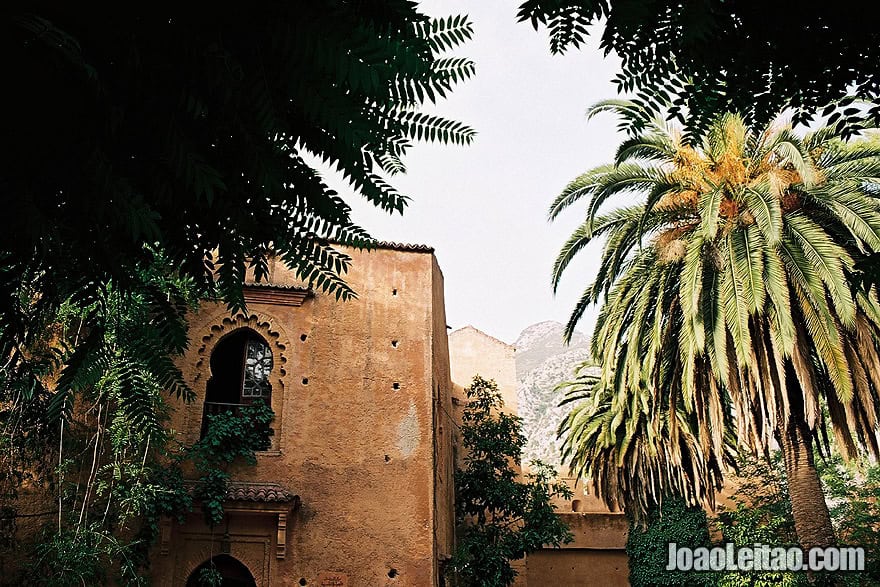
The Chefchaouen Kasbah is small but charming. Keep in mind that what you see today is the result of recent renovations, where there are practically no medieval constructions left.
There you’ll find a beautiful green space, where you can visit the Ethnographic Museum in the center and an art gallery. Ideally, try getting to the top of the main tower in the Kasbah (10 Dirhams) to enjoy the spectacular views of the city.
3. Plaza Uta el-Hammam
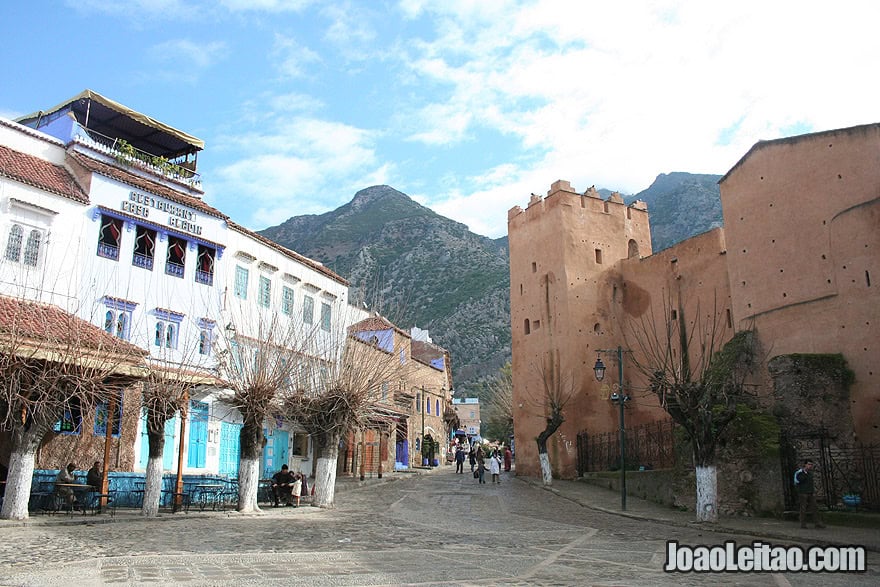
Chefchaouen’s main square is the place where everything happens, an excellent location for people-watching. You can spend a whole day there if you have the time to spare, and never grow tired of the city’s locals coming and going.
Architecturally it’s a charming place, combining the old Arabic influences with the trends brought by the Spanish, established here between 1920 and 1956.
This is the place to come to when you’re hungry. Between well-established restaurants and street food stalls, there are plenty of options to find a great meal.
From the square’s esplanades, you can see the mountains around the city, and there’s not a better place in the world to spend some hours with a good book and mint tea.
4. Hammam
At Chefchaouen’s main square, Plaza Uta el-Hammam, there are two hammams (local baths) where you can have an authentic Moroccan experience. The public hammam is right after the Castellana Pension but beware that men and women must attend at different times and different days. The fee to use the facilities, which are generally quite clean, is 25 Dirhams but the customer must bring their own slippers, soap, and a towel.
If that option doesn’t suit you, or if you’re looking for something more luxurious, head to Art du bien-être, a sort of fully equipped spa on the street west of the square, behind the Mosque. It doesn’t have the same traditional appeal as the other one, and it’s best to book ahead. Expect to pay between 150 (just for baths) and 250 Dirhams (for a complete spa treatment).
5. Ethnographic Museum
This small museum at the Kasbah is sometimes just known as the Kasbah Museum. It’s set in an old building that dates back to the foundation of Chefchaouen. It was established in 1985, and it’s usually open every day from 8 a.m. to 6 p.m. The admission fee costs 10 Dirhams.
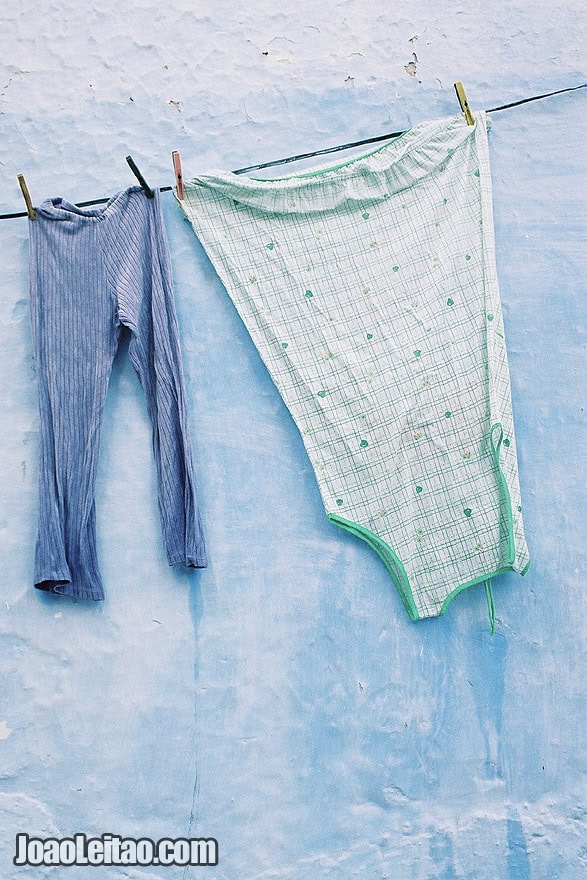
The place where the museum is set is perfect and adds value to the permanent collection, showcasing historical and ethnographic traits of the city and its community, over five centuries of traditions that cross local tribal customs with foreign influences from al Andalus.
The collection is organized in six different areas, with dedicated rooms to carpentry, traditional weapons, embroideries, musical instruments, and traditional clothes. The museum includes a small art gallery.
6. Grand Mosque
The Grand Mosque is located on the top of the same hill where you’ll find the Chefchaouen historic center. It dates back to the 15th century, built by orders of the city founder, and it’s famous for its octagonal minaret, a one-of-a-kind shape in the world. Please note that if you’re not Muslim, you can only visit the outside of the mosque, because in Morocco the “infidels” are not allowed inside.
Other mosques to visit in Chefchaouen: Sidi Ali ben Rachid Mosque, Onsar Mosque, Sidi Buhansa Mosque.
7. Chefchaouen Souk
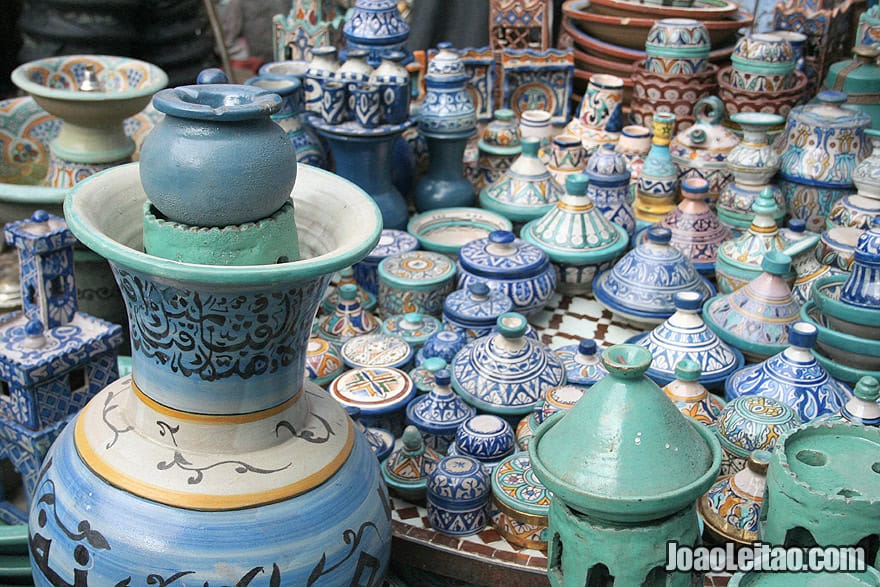
The Chefchaouen souk (or market) is different from the others: the vendors’ attitude is usually different from the ones you’d find in other Moroccan markets. They give more room to potential customers, and they don’t try to push the sale. And that is not the only significant advantage.
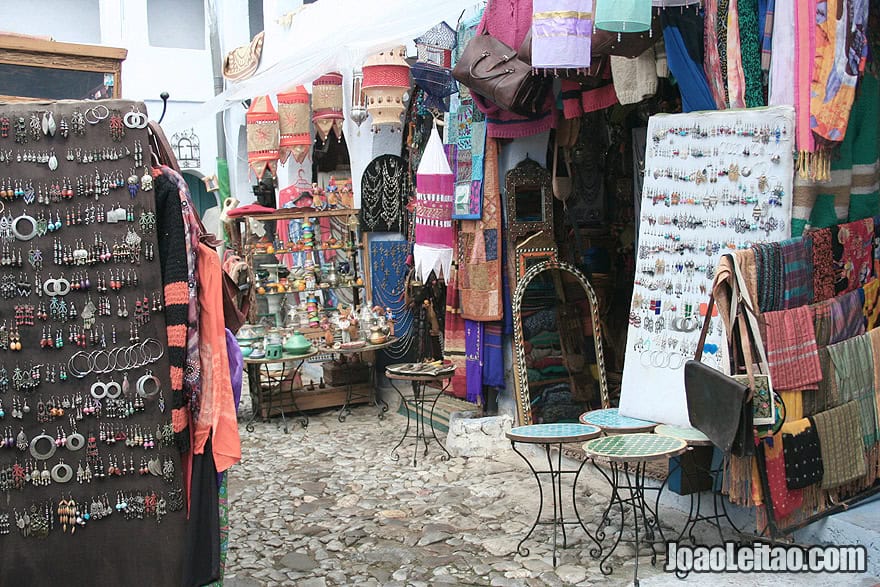
From the earliest time of day, the big Chefchaouen market is already full of life, with busy farmers that come to the city from neighboring villages and farms.
8. Spanish Mosque
The Spanish Mosque is a bit further from the medina, at about 2 km from the historic city center. The location is privileged, on the top of a hill from where you have unobstructed views over Chefchaouen. You’ll find more ruins than an actual mosque, due to its sad history. The Spanish built it in the 1920s, but most locals didn’t like the new temple and neglected it over the years. It underwent some renovation work later, but it was never used as a mosque again. It re-opened in 2010 and can be visited by everyone, considering it’s not an active temple.
You reach the Spanish Mosque from Bab al Ansar, the east gate of the old city. It’s a long walk so account for half a day to go and return (around 45 minutes each way, plus the time you need to enjoy the site and everything you might find along the way). On the way there, you can see the Ras el’Ma River and, if you’re lucky, spot some women doing their laundry. The whole trail is delightful, as local villagers coming to the city also use it.
It’s a particularly good trail to do at the end of the day so you can see the sunset from the top, as well as hear the call to the last prayer of the day.
Day 2 in Chefchaouen – What to Visit
1. Viewpoint
I call it a “viewpoint” although it isn’t one, officially. It’s just a spot from where you have the best views of Chefchaouen that are perfect for that classic panoramic photo. To reach here, walk up the hill from the medina towards the Atlas Hotel (it’s one of the biggest and best-known buildings of the city, so you can’t miss it). From there, if you can’t find the trail, ask the hotel receptionist.
After you’ve reached the “viewpoint,” and if you have the time and patience, you can continue your walk deeper inside the mountain.
2. Ras el-Ma
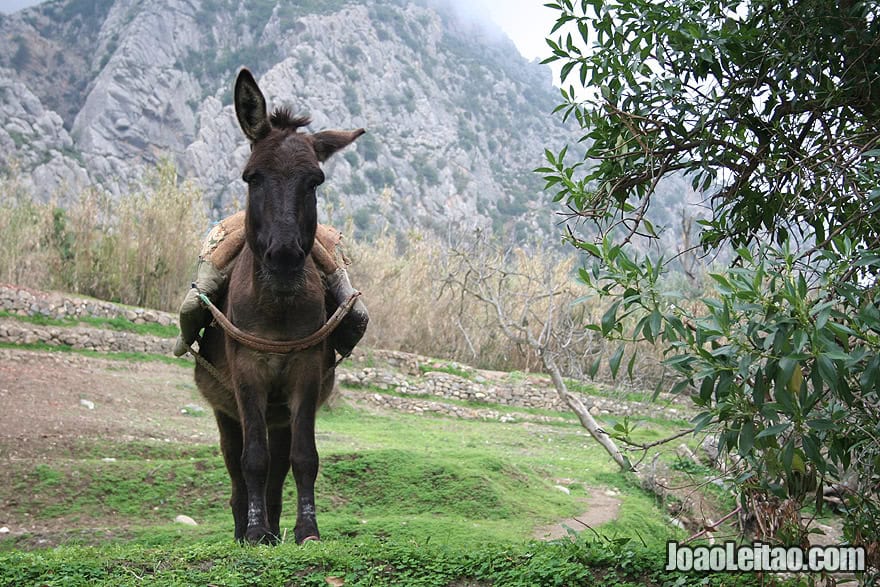
Outside the medina, the Ras el-Ma is a place where the river cascades into small waterfalls. A trendy spot among locals who come here for leisure and socializing.
This is also where people collect water for house use, for drinking, and where women do their laundry.
It’s especially lovely and surprisingly cool in the hot summer days. No wonder so many people in the city come to Ras el-Ma.
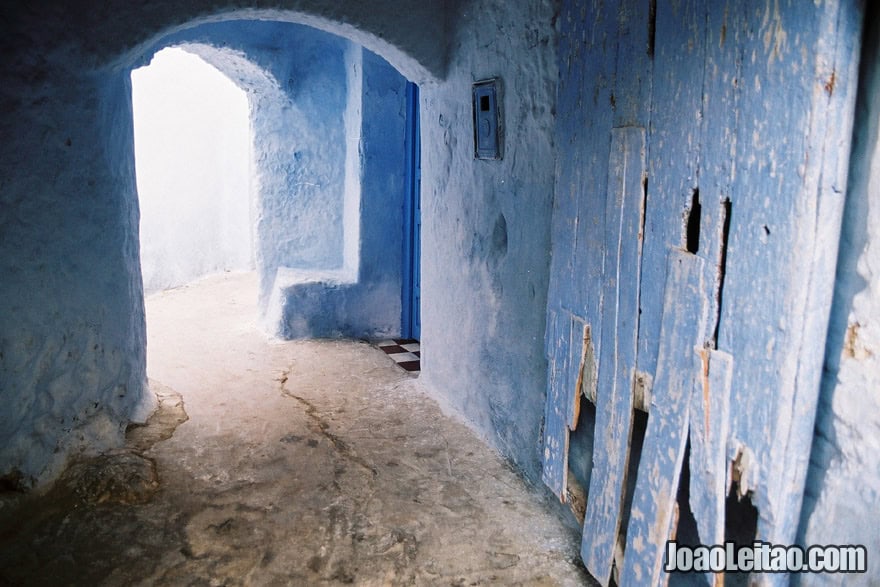
3. La Iglesia
This building was once a church built by the Spanish and is currently used as a theater.
4. Bab el Ain
This is one of the main access doors to the Chefchaouen medina, located on the south side next to a vast cemetery. It’s an imposing structure, built in terracotta-colored stone, with a relatively small arch through which people enter.
You can also visit the other gates in the city: Bab el-Mahrouk, Bab Souq, and Bab el-Ansar.
What to visit Around Chefchaouen
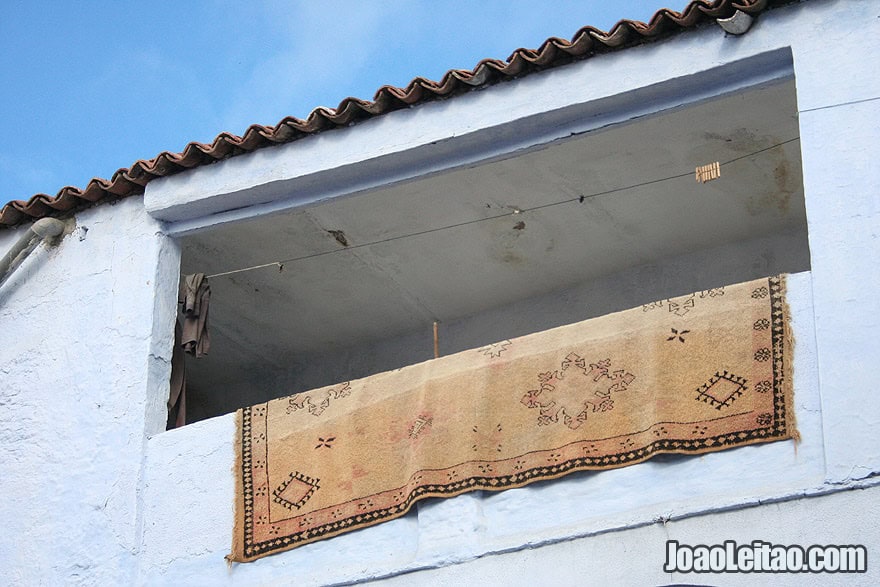
1. Akchour Waterfalls
These beautiful waterfalls don’t have the same human framing as the Ras el-Ma ones, but the peacefulness and the opportunity of getting close to nature are something else. These cascades are more spectacular and, besides, it’s just a 30-minute taxi ride (around 300 Dirham, round trip) and a good hike away. In this same location, you can visit the so-called Bridge of God, a natural stone arch that, like a bridge from the gods, crosses the river.
2. Talassemtane National Park
The Rif Mountains might not be as famous as the Atlas, but they’re no less impressive, and part of this mountain ridge is very close to Chefchaouen. At the Talassemtane National Park, that begins near Chefchaouen, there are 580 square kilometers of excellent hiking trails, where you can visit picturesque villages like El-Kelaâ and where you can walk for days in the middle of Nature.
3. Zaouia of Moulay Abdeslam Ben Mchich Alami
This is a mausoleum located on the Rif Mountains, about an hour-drive from Chefchaouen. It was built in the 13th century, before Chefchaouen was founded, to hold the remains of Moulay Abdeslam Ben Mchich Alami, a Sufi saint. Please note that only Muslims can cross the green door of the mausoleum.
Tours in Chefchaouen
How to Get to Chefchaouen
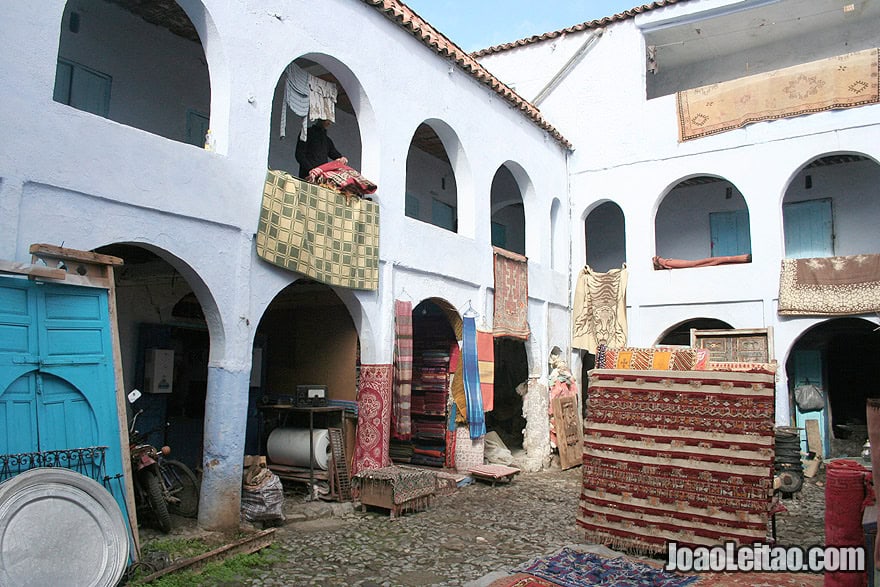
The best way to reach Chefchaouen depends on where you’re departing from. If you’re coming from outside Morocco, you’re probably departing from Europe. In that case, you can cross the Gibraltar Strait to Ceuta and from there take the bus to Chefchaouen, which doesn’t always mean a straight connection.
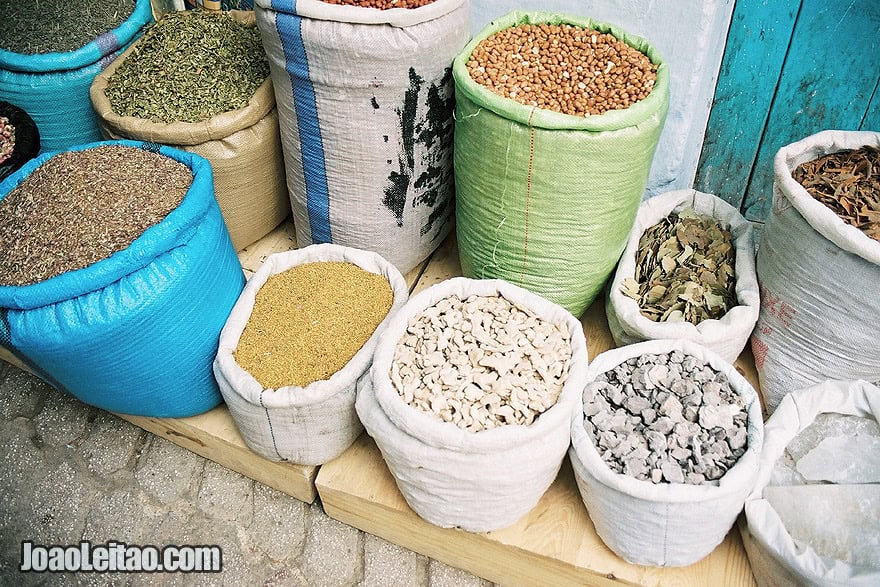
However, if you reach Tetouen, you’ll have five CTM bus connections per day (4.00 a.m. and 2.15, 3.15, 6.30, and 8.30 p.m.) that take about one hour and a half and cost 25 Dirhams. In addition to these options, you have over a dozen local buses.
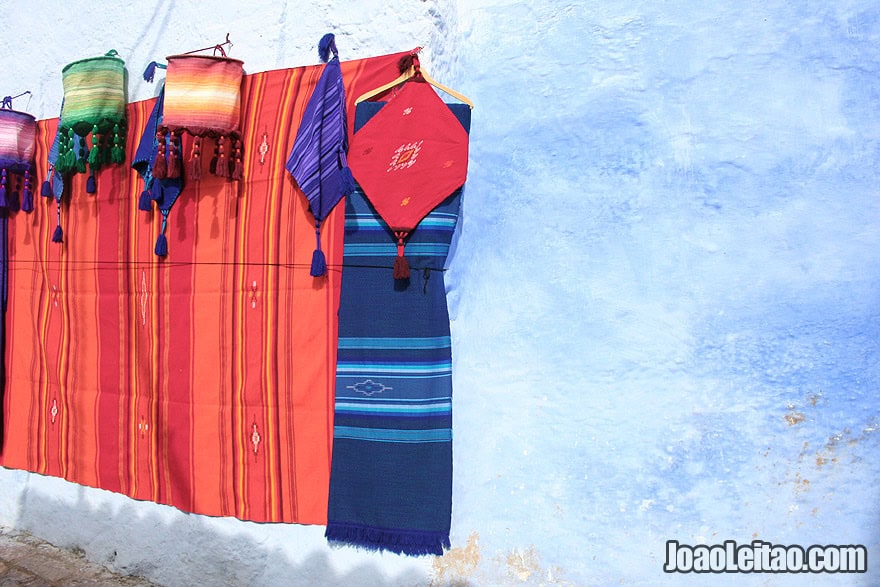
If you wish to fly into Chefchaouen, you’ll probably land in Tangier, to where Ryanair flies from Madrid, Seville, and Valencia, to mention just the departure cities from Spain. From Tangier, there are two CTM buses to Chefchaouen, leaving at 3.15 and 8.30 p.m., that cost 45 Dirhams and take three hours to reach.
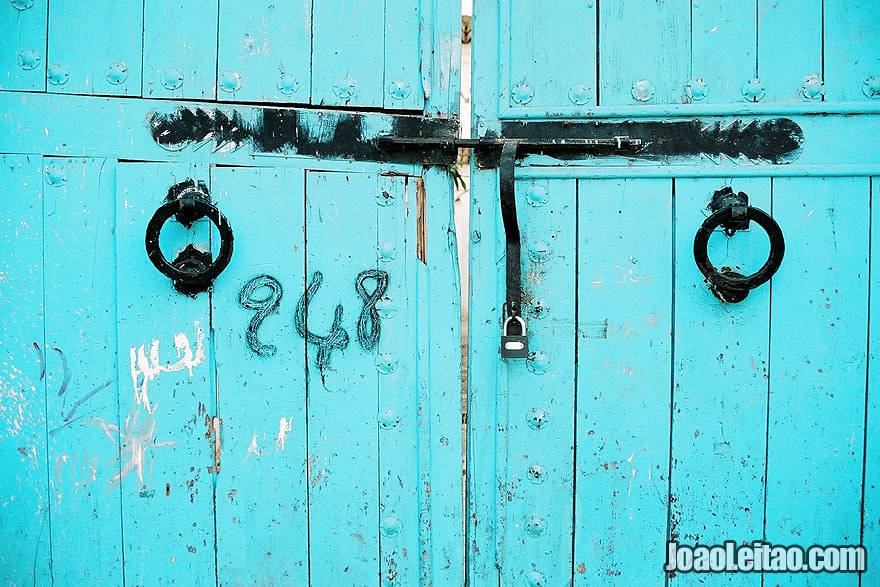
If you’re already in Morocco, CTM buses are usually the best option to reach Chefchaouen, because there are no trains to this city. Rabat and Casablanca have a daily CTM connection and a few other local options. Four CTM buses depart Fez every day (at 10.45 a.m, and 1.15, 3.15, and 6 p.m., for 45 Dirhams, 4-hour trip). If you’d rather take a Grand Taxi, expect to pay around 70 Dirham per person to Tetouan or Tangier.
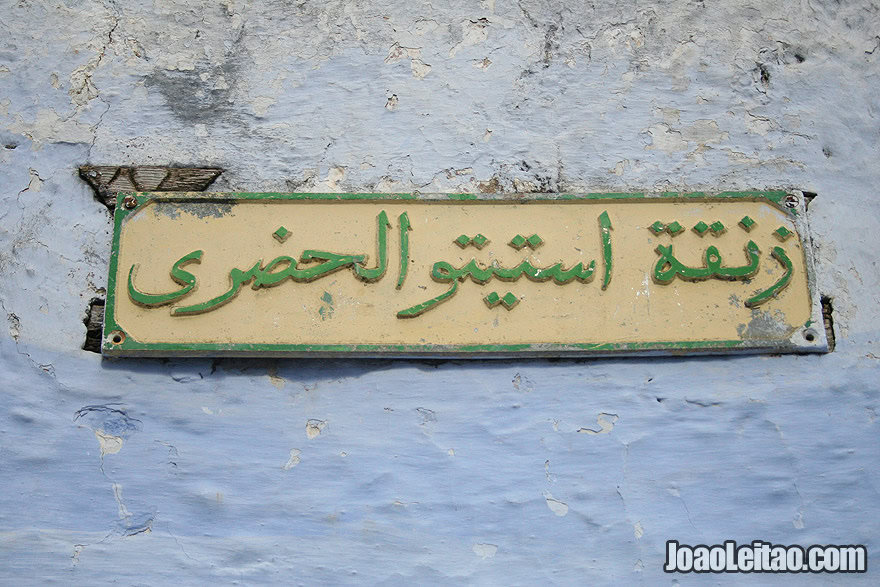
Supratours Bus official website
If you’re coming from the south, from Marrakesh or Ouarzazate, it’s best to catch the night train to Tangier. It’s about a 10-hour trip and expect to pay around 370 Dirhams (for a shared car with four beds) or 480 Dirhams (for a private car).
Where to Sleep in Chefchaouen
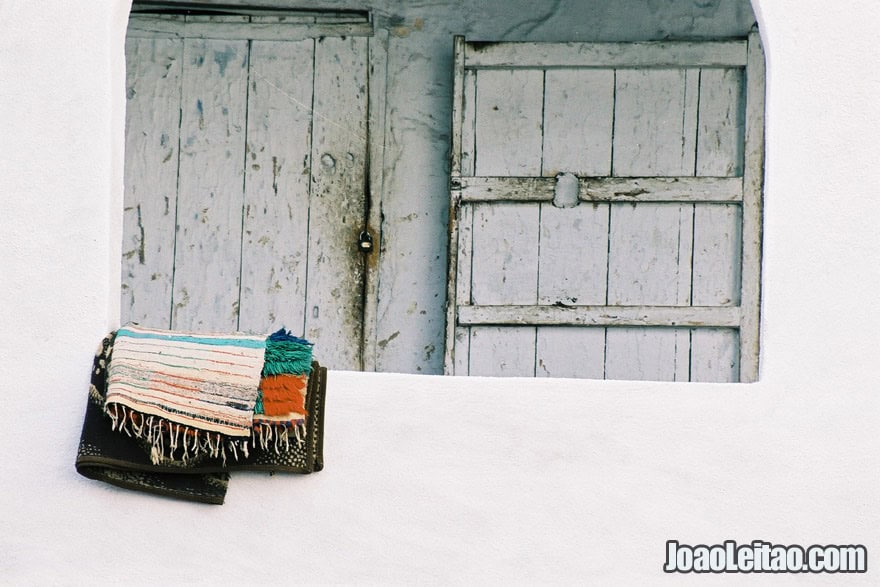
The city has a good variety of accommodation options, for all styles and budgets.
- On the affordable range, I’ll suggest Dar Antonio, a traditional house managed by António and his brother, with beautiful décor and an excellent location, about 200 meters from the center of the medina. Although breakfast is not included, there’s a pleasant terrace with mountain views. The cheapest double room with shared bathroom costs around 25 Euros.
- Hotel Sandra is also a good option within the same price range.
- On the mid-range, I suggest Casa Sabila in the center of Chefchaouen, with pleasant and toned-down décor, without traces of the famous blue. The beautiful and cozy terrace stands out, perfect from some needed R&R. A hearty breakfast is included, and the room costs around 55 Euros, with a private bathroom.
- On the deluxe range, with prices around 85 Euros for a double room, I suggest Dar Elrio, with top amenities that include a mini-bar, private bathroom and terrace, breakfast, and much more pampering.
Read my pages:
Visit Marrakesh: 3-day Travel Guide to the Red City
Visit Fez – Morocco: 2-day Travel Guide to the Mecca of the West
Visit Essaouira – Morocco: 2-Day City Guide to the Wind City



